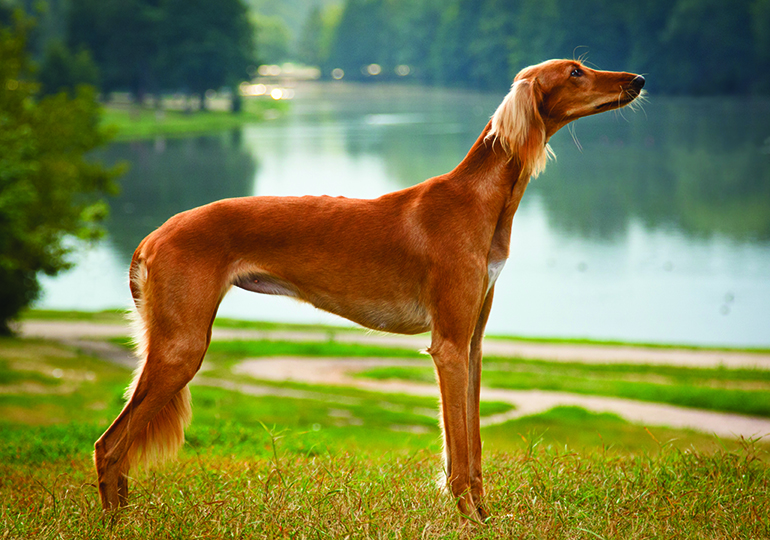
GROUP 4 - HOUNDS
One of the oldest dog breeds in the world, the proud and noble Saluki is originally from Mesopotamia. The breed belongs to the gazehound family, hunting game by sight rather than smell.
Known as the ancient hunting hound of the Middle East, the Saluki was an indispensable hunting companion to nomadic Bedouin tribes.
Egyptian tombs and Assyrian temples depict the Saluki as early as 5000 BC. Excavations of the ancient Sumerian Empire suggest this breed has remained physically unchanged in appearance for possibly 7000 years.
The Saluki doesn’t have a single country of origin, as it was found throughout Iran, Iraq, Turkey and the Arabian Peninsula. The breed was introduced to Europe in the 12th century by troops returning from the Crusades.
As an archetype gazehound, the Saluki must possess the characteristics that allow it to perform its original function. Variation is a key trait in this breed and its characteristics will depend on the type of terrain and quarry it was bred for. The ideal Saluki has a deep chest, fine waist, low hocks, broad hindquarters, a bladed bone and hare-like feet. There are both smooth and feathered varieties of the Saluki, judged together as one breed.
The breed must move with efficiency and speed, exhibiting more of a gallop rather than a trot. Its speed is phenomenal. Once it starts to walk and gain speed, its paws appear to never touch the ground – a legacy from its history of hunting agile gazelles and rabbits.
It should appear effortless, light, smooth, lifting and flowing, showing both reach and drive. Viewed from front or rear, the breed’s limbs converge to a centre line of travel, but do not single track at a slow trot. Front and rear extension must be balanced, with no side stepping, crossing or interfering. Gait should be evaluated at a moderate pace. The head is carried elegantly, forward from the vertical, creating a graceful, flowing line from nose to tail.
Strikingly beautiful, intelligent and affectionate, the Saluki will rule the roost if given half a chance. It’s hard to go past the breed’s feathered or smooth coat. The breed can sometimes be described as aloof and arrogant, which can make Obedience training a challenge – patience is paramount. It really enjoys Agility, if it can be on its terms.
The Saluki is an elegant endurance hound with functional athleticism. Almost alone among the breeds, Salukis vary enormously in type and each type is correct.
From the smallest to the biggest, and almost square to longer than tall, each type complies with the general appearance without exaggeration or coarseness. The key word for this breed is moderate; if any feature stands out there is something out of balance. Feathering can be profuse or fairly sparse. The smooth variety has no guard hairs and any colour or combination is permissible.
Height should average 58-71cm, bitches proportionately smaller.
The Saluki is a short-coated breed. It requires bathing just the same as other short-coated pets and the feathered Saluki needs a pin brush regularly to detangle the knots around the ears, backs of the legs and tail.
A daily walk or run is essential, but if there are other dogs in the family it will quite often exercise itself with other dogs. A fully fenced backyard is recommended as the Saluki can jump quite high.
In general, the Saluki is a healthy dog, but hypothyroidism may affect the breed at times.
There may also be a little thinning of the hair on the buttocks in some dogs. The primary health concern of a Saluki, as with other sighthounds, is its sensitivity to certain anaesthetic agents. Some anaesthetic agents rely on body fat to dissipate the drug. In breeds with little fat storage, these types of anaesthetic agents tend to take longer to dissipate, resulting in difficulty for the Saluki to wake up.
Overall, the Saluki is sound in health and has an average life expectancy of approximately 12 to 14 years.
Whether you are looking to add a Saluki or other breed to your family, it’s always wise to purchase a puppy from an ethical registered breeder who tests their breeding stock for any health problems.
Words: Cathy Smith
Image: Shutterstock.com
Now you know a little about the Saluki you may have think that this is the dog for you. Before you make a decision, please make contact with the breed club or your State controlling body for purebred dogs. They will be able to give you information about available puppies and also suggest dog shows where you can see the breed and speak to breeders. In this way you will gain a better perspective of the Saluki and its needs and whether this breed would suit your lifestyle.